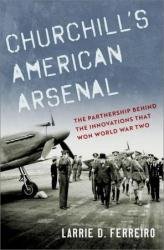 Название: Churchill's American Arsenal: The Partnership Behind the Innovations That Won World War Two
Название: Churchill's American Arsenal: The Partnership Behind the Innovations That Won World War TwoАвтор: Larrie D. Ferreiro
Издательство: Oxford University Press
Год: 2023
Страниц: 432
Язык: английский
Формат: epub (true)
Размер: 14.4 MB
Churchill's American Arsenal reveals how the technology, know-how, and production power behind the victorious Allied partnership during World War II extended beyond the battlefront and onto the home-front.
Many weapons and inventions were credited with winning World War II, most famously in the assertion that the atomic bomb "ended the war, but radar won the war." What is less well known is that both airborne radar and the atomic bomb were invented in British laboratories, but built by Americans. The same holds true for many other American weapons credited with the Allied victory: the P-51 Mustang fighter, the Liberty ship, the proximity fuze, the Sherman tank, and even penicillin all began with British scientists and planners, but were designed and mass-produced by American engineers and factory workers. Churchill's American Arsenal chronicles this vital but often fraught relationship between British inventiveness and American technical might.
At first, leaders in each nation were deeply skeptical that such a relationship could ever be successful. But despite initial misunderstandings, petty jealousies, and continuing differences over priorities, scientists and engineers on both sides of the Atlantic found new and often ingenious ways to work together, jointly creating the weapons that often became the decisive factor in the strategy for victory that Churchill had laid out during the earliest days of the conflict. While no single invention won the war, without any one of them, the war could have been lost.
In September 1940, at the height of the Battle of Britain, over a year before the United States entered the war, Churchill had summarized his plans for a strategic air campaign in a minute to his Cabinet: “Bombers alone provide the means of victory . . . we must develop the power to carry an ever-increasing volume of explosives to Germany.” He knew that the current state of heavy bombers was inadequate to the task. The first few daylight raids against Germany, conducted by unescorted bombers in December 1939, had resulted in the loss of almost half the aircraft and crews, first to anti-aircraft guns and then to fighters. RAF Bomber Command subsequently operated its squadrons—composed mostly of Halifax, Stirling, and Lancaster bombers—at night. However, without precise navigational aids they could barely find, let alone hit, their targets. When the pilots and crews of the American 8th Bomber Command came into the war in early 1942, they discovered that operating in overcast conditions—typical of Britain and northern Europe—also required precise navigational aids.
The combined strategic air campaign would depend on building three capabilities: locating targets at night or in overcast conditions; running the gauntlet of German radar-enabled anti-aircraft guns; and (though this would be slower in coming) arriving over the targets escorted by long-range fighters. All of these required novel technical solutions, as the prime minister explained in another Cabinet minute in October 1940. This war would not be about “masses of men hurling masses of shells at each other.” It would be won by “devising new weapons, and above all by scientific leadership.” Churchill announced that “very highest priority in personnel and material should be assigned to what may be called the Radio sphere.” This meant finding “scientists, wireless experts, and many classes of highly skilled labour and high-grade material. Not only research and experiments, but production, must be pushed hopefully forward.”
Скачать Churchill's American Arsenal: The Partnership Behind the Innovations That Won World War Two